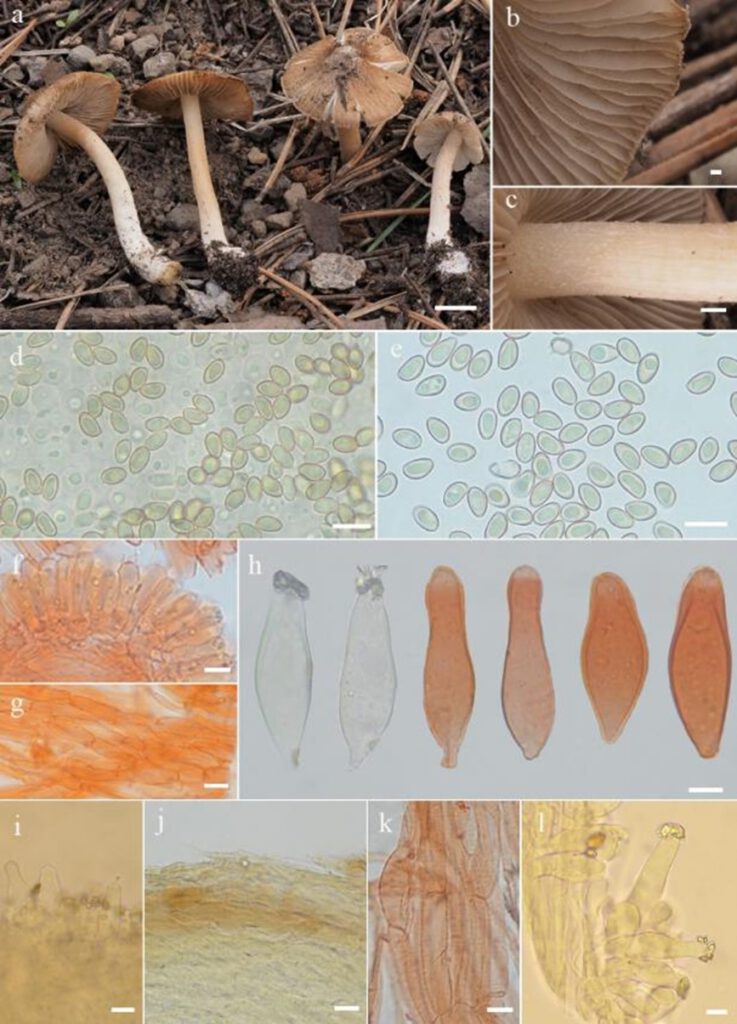Inoycbe meirensonggia Y.G. Fan, W.J. Yu & L.S. Deng
MycoBank number: MB 558418; Index Fungorum number: IF 558418; Facesoffungi number: FoF 10614;
Description
Basidiomata small-sized. Pileus 8–20 mm, conical when young, then convex, broadly convex to plano-convex with a distinct umbo; surface dry, uniformly earth yellow to brownish yellow or brown, smooth, appressed scaly, or sometimes with a grayish white layer of velipellis around the disc, appressed-fibrillose elsewhere, margin depressed at first, becoming straight, usually splited to strongly so. Cortina absent. Lamellae 1.5–2.5 mm wide, adenexed, moderately crowded with at least three tiers of lamellula, white, grayish white to yellowish, concolorous with side. Stipe 20–38 × 2.5–3.5 mm, central, solid, equal at upper half, thicker downwards the lower half, pinkish or flesh-colored, pallid and pruinose at stipe apex, densely covered with erupted, tiny fibrils elsewhere, longitudinally fibrillose, base whitish. Context white in pileus, fleshy, 0.5–1 mm at mid-radius, 1.5–3 mm under the umbo, flesh-colored in stipe, fibrillose, shiny. Odor spermatic. Basidiospores 7.4–8.5 (9) × (4.3) 4.5–5 (5.2) µm (x̅ = 8 × 4.8 µm, n = 44), Q = (1.5) 1.52–1.86 (1.95), Qm = 1.67, ellipsoid, ovoid to occasionally subamygdaliform, smooth, yellowish, with oily droplets inside. Basidia 23–30 × 7–9 µm (x̅ = 27 × 8 µm, n = 15), clavate, yellowish, hyaline or with a few intracellular contents. Pleurocystidia 42–65 × 12–23 µm (x̅ = 52 × 18 µm, n = 17), yellowish, hyaline, fusiform, broadly fusiform, utriform or lageniform; thick-walled, walls 0.5–1(–2) µm thick, apices rounded, crystalliferous, base usually tapered into small pedicels. Cheilocystidia scattered at lamellae edge, mixed with basidia, not abundant, resemble pleurocystidia in size and shape. Cheiloparacystidia not observed. Hymenophoral trama yellowish, subregular, composed of thin-walled, cylindrical to mostly inflated hyphae (5–)10–30 µm wide. Pileipellis a cutis, pale yellow, composed of subregularly arranged, cylindrical to somewhat inflated hyphae 7–22 µm wide, yellowish walls, thin or slightly thickened, distinctly incrusted. Stipitipellis a cutis, hyphae densely and regularly arranged, cylindrical, yellow, thin-walled, 3–6 µm wide; commonly disrupted with clusters of caulocystidia mixed with cauloparacystidia at stipe apex and with clusters of thin-walled cystidia downwards the stipe. Stipe trama regular, yellowish, hyphae hyaline with yellow walls, 7–17 µm wide. Caulocystidia 33–55 × 12–15 µm, yellow, resemble pleurocystida in shape, but more variable. Cauloparacystida thin-walled, yellow, at times septate, terminal cells 20–35 × 10–13 µm, clavate, obovoid, or broadly fusiform. Oliferous hyphae present at pileus and stipe trama, bright yellow, diverticulate, 4–8 µm wide. Clamp connections present in all tissues.
Material examined: SWEDEN, CHINA, Jilin Province, Antu County, Erdaobaihe Town, under Pinus sylvestriformis (Pinaceae), 2 Aug 2019, WJ Yu & YG Fan, FYG3777 (FCAS3508, holotype); FYG3776 (FCAS3507).
Distribution: China
Sequence data: ITS: MZ322671 (ITS1F/ITS4), LSU: MZ322668 (LR0R/LR7), RPB2: MZ336924 (RPB2-6F/RPB2-7.1R)
Notes: The species is the first authorized report of Inocybe species associated with P. sylvestrifomis, which enriches the knowledge of ECM fungal diversity of this endangered plant.

Fig. 1. Inocybe meirensongia (FCAS3508, holotype). a Basidiomata. b Lamellae. c Stipe apex. d, e Basidiospores. f Basidia. g Hymenophoral trama. h Pleurocystidia. i Cheilocystidia at lamellae edge. j Pileipellis. k Pileipellis hyphae. l Caulocystidia and cauloparacystidia. Scale bars: a = 10 mm, b–c = 1 mm, d–h, k–l = 10 μm, i–j = 20 μm.
